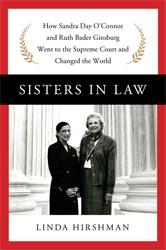A string of searing dissents in 2013 inspired Shana Knizhnik, then a law student, to create The Notorious RBG on Tumblr, a social-media site particularly suited for sharing images and memes. The blog was a viral hit, and the octogenarian Supreme Court justice has since enjoyed the adoration of a legion of young fans who share and enjoy her now-ubiquitous image everywhere from the Internet to coffee mugs and T‑shirts. Irin Carmon has channeled both the surface whimsy and underlying substance of the meme into her biography, Notorious R.B.G: The Life and Times of Ruth Bader Ginsburg.
A visual delight, The Notorious R.B.G. is a rich translation of a Tumblr blog into a book. It is richly illustrated with pictures, timelines, and charts as well as many images taken from the Tumblr. The heart-breaking final letter written to Ginsburg by her late husband, Marty, is reproduced, and its appearance in the same book as selfies by fans dressed as her for Halloween is not in any way incongruous. Key selections from Ginsburg’s writings and opinions are reproduced and interspersed throughout the book, with key lines circled and annotations “drawn” into the margins. At the same time, space is dedicated to Ginsburg’s favorite recipes and workout routine. Chapter headings are repurposed “Notorious B.I.G.” rap lyrics, in a graffiti-inspired typeface. As a New York Times reviewer wrote, the overall feel is a combination of scrapbook and Talmud; it embodies the study in contrasts that made the meme so compelling.
Despite many years of experience as a journalist, Carmon’s work has heretofore rarely appeared on physical paper — unless it is printed out. Her career has taken her from Jezebel, part of the Gawker network of blogs, to the news and opinion site Salon, and then to MSNBC.com. Even in book form, her writing retains the conversational, informal tone that has served her well online. It is detail-oriented and thorough, but also excited, personal, and strongly opinionated.
Past ACLU coworkers of Ginsburg’s described her as “by no means a bomb-thrower,” though “the things she achieved were bombshells.” In other words, Carmon explains, Ginsburg was a radical simply by achieving the things that she did — carving a place for herself in a world that did not accommodate women — with dedication to her work, resolute belief in her cause, and exceptional talent.
As conservatives regained a majority of the Supreme Court, Ginsburg’s output has become more prolific, and her tone has become more strident, as she has taken up the fight to defend the victories she achieved over the course of her life and career. For millennials like Carmon and Knizhnik, that shift turned Ginsburg from a respected elder statesman to a warrior they have enthusiastically rallied behind.
It is therefore fitting that some of the final images in the book are selfies of Carmon and Knizhnik with Ginsburg, because they are, themselves, part of the book’s story. Ultimately, the book does more than explain why Ginsburg is a historically important figure; it also demonstrates why Ginsburg is important to the authors and to like-minded members of their generation.
Related Content:
- Ruffled Collars: Excerpt from Sisters in Law by Linda Hirshman
- Book Cover of the Week: Notorious RBG
- Women’s History Month Reading List




